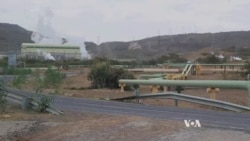Kenya’s Rift Valley, a rich source of geothermal power, is now being touted as the answer to the country’s energy problems. But most of the drilling sites are in natural parks, the source of important tourism income. Kenya is facing trade-offs as the growing need for power comes into conflict with more traditional values of conservation.
The Rift Valley cuts a broad, magnificent swath through the heart of Kenya. Its cliffs, lakes and grasslands teem with wildlife. National parks and protected areas are scattered along the length of the valley, and for some species, these havens are their last hope for survival.
But these days Kenya’s human population is depending more heavily on the Rift Valley as well - for electricity.
The Olkaria geothermal power plant produces 280 megawatts of geothermal power, enough to serve the needs of 500,000 homes. And there is talk of expanding it, as Kenya plans to generate 5,000 geothermal megawatts by 2030. Tapping geothermal energy has already reduced power prices, and promises to boost economic growth in a country where only 23 percent of the population have access to electricity.
But Olkaria Geothermal facility sits inside Hell’s Gate, a national park, and as local conservationist Silas Wanjala explains, other parks are on the geothermal radar.
“Previous geothermal surveys have indicated the entire Kenyan Rift Valley to be potential for geothermal power generation. It is a coincidence that these areas are also the only main areas in which we have important biodiversity,” said Wanjala.
Geothermal is considered a relatively green and sustainable source of energy. But as the tarmacked roads and billowing steam vents of Olkaria demonstrate, it is difficult for any industry to avoid disrupting such a delicate ecosystem.
Simon Thomsett has worked with the birds of Hell’s Gate for decades. He said that for many rare species, the plant has been devastating.
“Everybody recognized it was a fantastic location for raptors. It is full of cliffs, and so that means you have got eagles and vultures that nest on the cliffs. We lost the Lammergier in 1979, we lost the white-backed vulture, and then we started to have a cascade of losses. And the single reason is because of the power generation in the park,” said Thomsett.
The vegetation of the park has also changed, said Wanjala, and large mammals like buffalo are not as healthy as they used to be.
Local guides say the development is hurting tourism, and threatening their main source of income.
Tour guide Robert Kiambati grew up near the park. He said he does not blame visitors for being disappointed.
“The Hell’s Gate that they knew in the past is what they see in the advertisement. But the real picture on the ground is quite different. Some tourists complain, and actually on several occasions, we found some even asking for some refund because they did not expect such development in the park. For them it is more of an industrial park than a national park,” said Kiambati.
But Thomsett said it is hard for conservationists to win in the face of Kenya’s bottomless thirst for energy.
“The Wildlife Act is obliged to protect our endangered species, especially. But we also have the needs of the country to produce the power. So there is a huge area of conflict. One side has got to win, and now who has won is the energy side,” said Thomsett.
Kenya is not the only African country facing the choice between conservation and keeping the lights on, and with Africa’s population predicted to explode during the next few decades, so will its demand for electricity. It appears this conflict has only just begun.






